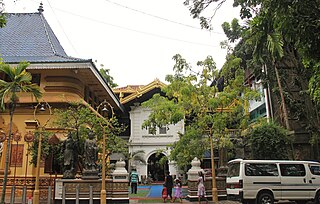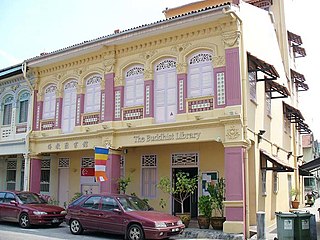Related Research Articles

Dar es Salaam is the largest city and financial hub of Tanzania. It is also the capital of the Dar es Salaam Region. With a population of over five million people, Dar es Salaam is the largest city in East Africa and the sixth-largest in Africa. Located on the Swahili coast, Dar es Salaam is an important economic center and one of the fastest-growing cities in the world.
Theravāda is the most commonly accepted name of Buddhism's oldest existing school. The school's adherents, termed Theravādins, have preserved their version of Gautama Buddha's teaching or Buddha Dhamma in the Pāli Canon for over two millennia.

The Bodhi Tree, also called the Mahabodhi Tree, Bo Tree, is a large sacred fig tree located in Bodh Gaya, Bihar, India. Siddhartha Gautama, the spiritual teacher who became known as the Buddha, is said to have attained enlightenment or buddhahood circa 500 BCE under this tree. In religious iconography, the Bodhi Tree is recognizable by its heart-shaped leaves, which are usually prominently displayed.
Buddhism in the West broadly encompasses the knowledge and practice of Buddhism outside of Asia in the Western world. Occasional intersections between Western civilization and the Buddhist world have been occurring for thousands of years. The first Westerners to become Buddhists were Greeks who settled in Bactria and India during the Hellenistic period. They became influential figures during the reigns of the Indo-Greek kings, whose patronage of Buddhism led to the emergence of Greco-Buddhism and Greco-Buddhist art. There was little contact between the Western and Buddhist cultures during most of the Middle Ages but the early modern rise of global trade and mercantilism, improved navigation technology and the European colonization of Asian Buddhist countries led to increased knowledge of Buddhism among Westerners. This increased contact led to various responses from Buddhists and Westerners throughout the modern era. These include religious proselytism, religious polemics and debates, Buddhist modernism, Western convert Buddhists and the rise of Buddhist studies in Western academia. During the 20th century, there was a growth in Western Buddhism due to various factors such as immigration, globalization, the decline of Christianity and increased interest among Westerners. The various schools of Buddhism are now established in all major Western countries making up a small minority in the United States, Europe, Australia and New Zealand.

The World Fellowship of Buddhists (WFB) is an international Buddhist organization. Initiated by Gunapala Piyasena Malalasekera, it was founded in 1950 in Colombo, Ceylon, by representatives from 27 nations. Although Theravada Buddhists are prominent in the organization,, members of all Buddhist schools are active in the WFB. It has regional centers in more than 30 countries, including India, the United States, Australia, and several nations of Africa and Europe, in addition to traditional Buddhist countries.

Gangaramaya Temple is one of the most important temples in Colombo, Sri Lanka, being a mix of modern architecture and cultural essence. Located on the Beira Lake, it was completed in the late 19th century.

Theravada Buddhism is the largest and official religion of Sri Lanka, practiced by 70.2% of the population as of 2012. Practitioners of Sri Lankan Buddhism can be found amongst the majority Sinhalese population as well as among the minority ethnic groups. Sri Lankan Buddhists share many similarities with Southeast Asian Buddhists, specifically Myanmar Buddhists and Thai Buddhists due to traditional and cultural exchange. Sri Lanka is one of five nations with a Theravada Buddhist majority.

The City of Ten Thousand Buddhas is an international Buddhist community and monastery founded by Hsuan Hua, an important figure in Western Buddhism. It is one of the first Chan Buddhist temples in the United States, and one of the largest Buddhist communities in the Western Hemisphere.

The University of Dar es Salaam (UDSM) is a public university located in Ubungo District, Dar es Salaam Region, Tanzania. It was established in 1961 as an affiliate college of the University of London. The university became an affiliate of the University of East Africa (UEA) in 1963, shortly after Tanzania gained its independence from the United Kingdom. In 1970, UEA split into three independent universities: Makerere University in Uganda, the University of Nairobi in Kenya, and the University of Dar es Salaam in Tanzania.

Buddhism, specifically Theravāda Buddhism, is the official and state religion of Myanmar since 1961, and practiced by nearly 90% of the population. It is the most religious Buddhist country in terms of the proportion of monks in the population and proportion of income spent on religion. Adherents are most likely found among the dominant Bamar people, Shan, Rakhine, Mon, Karen, and Chinese who are well integrated into Burmese society. Monks, collectively known as the sangha (community), are venerated members of Burmese society. Among many ethnic groups in Myanmar, including the Bamar and Shan, Theravada Buddhism is practiced in conjunction with the worship of nats, which are spirits who can intercede in worldly affairs.

Fo Guang Shan Nan Hua Temple is the largest Buddhist temple and seminary in Africa, and is situated in the Cultura Park suburb of Bronkhorstspruit, South Africa. It is the African headquarters of the Fo Guang Shan Order, covering over 600 acres (2.4 km2). Fo Guang Shan was established in 1967 by Venerable Master Hsing Yun, and is a Mahayana Chinese Buddhism monastic order. The Temple, like its mother order in Taiwan, follows the Linji Chan school of Buddhism as well as the Pure Land School.

The earliest evidence of Hinduism in Tanzania is from the 1st millennium AD when there was trade between East Africa and Indian subcontinent. Most of these traders came from Gujarat, Deccan and the Chola empire. Archaeological evidence of small Hindu settlements have been found in Zanzibar and parts of Swahili coast, Zimbabwe and Madagascar.

The Buddhist Library is the first dedicated Buddhist library in Singapore. The library, which is located in a shophouse in Geylang, aims to meet the needs of the Buddhist community and anyone interested in Buddhism. It is unique in that it is not a voluntary association or a temple and because it takes a non-sectarian approach to Buddhism. Besides functioning as a lending library, it also organises Dhamma talks, accredited Buddhist courses, public art exhibitions and welfare work locally and abroad.

Airtel Tanzania Limited is the third-largest mobile network operator in Tanzania operated by Airtel Africa, which is a subsidiary of Bharti Airtel of India, behind Vodacom Tanzania and Tigo Tanzania. As of September 2017, Airtel Tanzania had 10.6 million voice subscribers. As of December 2017 according to data provided by the Tanzania Communications Regulatory Authority, Airtel Tanzania controlled 27.1 percent of Tanzania's mobile telephone market by customer numbers, at that time estimated at 10.86 million.

Bodagama Chandima Thero is a Buddhist monk. As of 2015 he taught Theravada Buddhism in Taiwan. With a group of Taiwanese Buddhists, he founded the Theravada Samadhi Education Association in Taipei.

The Sri Lankaramaya Buddhist Temple is located at St. Michael's Road in Bendemeer, Singapore. The temple is the primary Sri Lanka Buddhist temple of its kind in Singapore. It is one of the Theravada Buddhist temples in Singapore which is founded years back from Buddhist monks from Sri Lanka. It is operated by the Singapore Sinhala Buddhist Association which was established in 1920.

Mahindarama Buddhist Temple is a Theravada Buddhist temple within George Town in the Malaysian state of Penang. The only Sri Lankan temple in the state, it is also one of the select few in Malaysia that houses the relics of the Buddha. The temple becomes a focal point for the annual Vesak Day festivities within the city.
Bakhresa Sugar Limited, whose official name is Bagamoyo Sugar Limited (BSL), is a sugar manufacturer in Tanzania, the second-largest economy in the East African Community.
The history of Theravāda Buddhism begins in ancient India, where it was one of the early Buddhist schools which arose after the first schism of the Buddhist monastic community. After establishing itself in the Sri Lankan Anuradhapura Kingdom, Theravāda spread throughout mainland Southeast Asia through the efforts of missionary monks and Southeast Asian kings.
The Church of Jesus Christ of Latter-day Saints in Tanzania refers to the Church of Jesus Christ of Latter-day Saints and its members in Tanzania. The first branch was organized in 1992. In 2021, there were 2,999 members in 23 congregations.